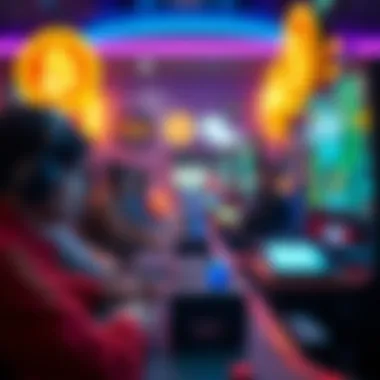Free-to-Play NFT Games: Merging Gaming and Crypto


Intro
As the digital landscape evolves, the world of gaming is not merely keeping pace but altering course in response to the rapid rise of cryptocurrency and blockchain technology. This transformative synergy has birthed an intriguing sector within the gaming realm: free-to-play NFT games. These games have developed a reputation for allowing players to earn while they engage, shifting the traditional perception of play, which often hinges on expenditure without any financial return.
Understanding Cryptocurrency Fundamentals
What is Cryptocurrency?
At its core, cryptocurrency is a type of digital or virtual currency that employs cryptography for security. Unlike traditional currencies regulated by governments or central banks, cryptocurrencies operate on a decentralized model, typically using blockchain technology. Bitcoin, Ethereum, and Cardano are among the most well-known names in this space, but hundreds of other cryptocurrencies also exist, each serving various purposes within the economic ecosystem.
How Blockchain Technology Works
Understanding blockchain is key to grasping how cryptocurrency intersects with gaming. A blockchain is essentially a distributed ledger that records all transactions across a network of computers. Here’s a quick rundown of its main features:
- Decentralization: Instead of a single entity controlling the network, multiple nodes validate transactions, enhancing security and reliability.
- Transparency: All transactions are recorded publicly, which means anyone can update or verify data.
- Immutability: Once a transaction is logged, it cannot be altered, ensuring accountability.
In the context of NFT games, this technology crucially distinguishes ownership. Each NFT, or non-fungible token, represents a unique asset on the blockchain, giving players actual ownership over in-game items, characters, or skins.
Market Insights and Trends
Current Market Trends and Analysis
In recent years, the NFT gaming market has witnessed unprecedented growth. Titles such as Axie Infinity and Decentraland have not only gained popularity but created economically viable ecosystems. Players often engage in transactions that can lead to substantial profits based on their in-game activities. Several trends are worth noting in this burgeoning market:
- Play-to-Earn Models: Many games are adopting this model, allowing players to earn cryptocurrency or NFTs as they play, which stands in contrast to traditional gaming practices where monetization primarily benefits the developers.
- Community-Driven Content: Players often have a say in the game's direction through governance tokens, reinforcing community and engagement.
Future Predictions and Investment Strategies
Looking ahead, analysts predict a continued rise in the adoption of NFT gaming as more users become aware of its benefits. Several investment strategies may guide those looking to delve into this space:
- Diversity of Assets: Investing in a varied array of NFTs—whether characters, skins, or real estate within games—can mitigate risk.
- Following Developers: Keeping an eye on game developers who are innovating with gameplay and economic models can provide clues about future successful investments.
- Understanding Market Dynamics: Awareness of the fluctuating value of cryptocurrencies and their impact on NFT prices is crucial for informed decision-making.
"NFTs are reshaping the economy of gaming, where playtime can lead to real-world returns—an opportunity that has never been present before".
Prelude to NFT Games
In today’s fast-changing digital landscape, the fusion of gaming and cryptocurrency has been nothing short of revolutionary. Free-to-play NFT games, in particular, have emerged as a fascinating intersection between traditional gaming principles and blockchain technology. This convergence is crucial not just for gamers, but also for developers and investors who see a burgeoning market worth exploring.
The sheer concept of NFT games introduces a new paradigm where digital assets possess verifiable ownership and can be traded. Unlike conventional games where the player’s achievements often remain locked within the system, NFT games empower players by giving them ownership of in-game assets that can appreciate over time. This represents a pivotal moment in how we perceive value in gaming.
Definition of NFT Games
NFT games are video games that utilize Non-Fungible Tokens (NFTs) on a blockchain, which allows for true ownership of digital items. Each NFT is unique in its identifiers, making it distinct from other tokens. This uniqueness can encompass various in-game assets, such as characters, skins, items, and even land. Imagine owning a rare sword with a digital certificate proving you’re the sole owner; that’s the magic of NFTs in gaming.
NFTs also enable cross-game asset utilization, meaning a player could, in theory, utilize their items across different games, provided those games support the same blockchain. This flexibility adds a new layer of freedom and excitement to the gaming experience.
"As gaming technology advances, so does the concept of ownership and value in this virtual world."
The Evolution of Gaming with Blockchain
Blockchain technology has been transforming various sectors, and gaming is no exception. Initially, gaming was viewed purely as a form of entertainment, with revenue streams tied to subscriptions, ad revenues, or in-game purchases. However, the advent of blockchain introduced new revenue potentials with the following key developments:
- Authentic Ownership: Players can buy, sell, or trade their assets with complete confidence, knowing that blockchain provides the underlying proof of ownership.
- Decentralization: Unlike traditional gaming models controlled by a single entity, blockchain allows for decentralized control, fostering community-driven ecosystems.
- Play-to-Earn Mechanics: A remarkable shift has been toward enabling players to earn money through their gameplay. Whether it's through winning battles or trading rare items, players can now monetize their time and effort.
As gaming continues to evolve with technological advancements, coupling gaming with blockchain not only enhances the experience but also gives players the financial agency that was previously absent in the gaming world. The potential is enormous, and as more developers dive into this space, the future of gaming looks promising.
Understanding NFTs in Gaming
The realm of NFTs (Non-Fungible Tokens) is at the heart of a paradigm shift in gaming. They bring an unprecedented breadth of value and ownership to players, unlocking fresh avenues for engagement and monetization. Understanding NFTs is essential in this article, primarily focusing on how they redefine player experiences, ownership rights, and the financial landscape of gaming. NFTs operate differently than traditional in-game assets, making them uniquely positioned to allow players to truly own, trade, and profit from their digital holdings.
What are Non-Fungible Tokens?
At their core, non-fungible tokens are one-of-a-kind digital assets enabled by blockchain technology. Unlike your run-of-the-mill cryptocurrencies like Bitcoin or Ethereum, which are interchangeable, each NFT is distinctly identifiable. Imagine owning a baseball card—each card may have similar features, but the specific card in your hand? That’s your own prized possession.
NFTs encapsulate items such as unique in-game skins, virtual real estate, or even characters, linking them to a digital certificate of authenticity. This means when you acquire an NFT through gameplay or purchase, it's yours in a much broader sense than just borrowing a friend's game. Once you've got it, it's stashed in your digital wallet, and you can trade or sell it, similar to how one might barter collector's items.


Here are key characteristics that define NFTs:
- Uniqueness: Every NFT is different from the other, verified through a digital ledger.
- Transferability: Players can buy, sell, or trade NFTs on various marketplaces, giving them liquidity.
- Programmability: Smart contracts can be embedded, enabling automatic transactions under certain conditions.
In sum, NFTs introduce a level of ownership and connection that was previously lacking in gaming. By enabling players to have tangible assets tied to their time and effort, they reshape the relationship between gamers and developers. This specificity and ownership lead us to the next focal point.
How NFTs Enhance Gaming Experiences
Non-fungible tokens are not just a gimmick; they augment the gaming experience substantially by enhancing engagement and investment. Here's how they do this:
- True Ownership: Players authenticate their ownership of unique items. Instead of developers retaining control, gamers wield agency over their assets. This shift leads to more meaningful interactions within the gaming context.
- Creativity and Customization: NFTs allow players to purchase or create custom skins or environments. This user-generated content has proven to amplify community involvement and individual creativity. Imagine a player designing a spaceship in a game and then selling it as an NFT—this not just rewards artistry but also encourages a diverse gaming ecosystem.
- Play-to-Earn Models: The introduction of NFT economies elevates the potential for players to earn while they play. The more time and skill you invest, the more value you derive from the game. Suddenly, gaming morphs from a mere pastime into a potential career path.
- Interoperability: Some games have begun allowing items to move between different platforms. This means your prized sword from one game could be used in another. Such flexibility is revolutionary, and it broadens player engagement across multiple games and communities.
- Community Building: Players are drawn into ecosystems that promote social interaction and trading. Community-driven initiatives often thrive in the NFT space. Players band together to create guilds, trade collaboratively, and share strategies, which further enriches the experience.
Transforming traditional models into opportunities for ownership, creation, and economic gain, NFTs not only reshape gameplay but also build a foundation for innovating futures within the industry. As we delve further into the specifics of free-to-play games, the significance of understanding NFTs becomes clear—with their unique assets leading to enriched experiences and increased earning potential.
The Mechanics of Free-to-Play NFT Games
The mechanics behind free-to-play NFT games lie at the crossroads of innovative gameplay and cryptocurrency technology. These games have reshaped the gaming landscape by allowing players to engage without any upfront cost, appealing to a vast audience that may have previously shied away from gaming due to financial barriers. Moreover, the integration of NFT technology adds a new layer of value, transforming how gamers interact with digital assets.
Understanding these mechanics is vital not just for players but also for investors and developers looking to navigate this burgeoning field. Success in this realm often hinges on drawing players in with enticing game dynamics while also allowing them to earn tangible rewards. The core elements that make these mechanics effective include how players get started, the models used for earning, and the various pathways through which they can capitalize on their engagement.
How to Get Started
Getting started with free-to-play NFT games often feels like stepping into a new world, filled with possibilities. Players usually need to create a wallet compatible with cryptocurrencies, such as MetaMask. This wallet is crucial as it's where players store their NFTs and any digital currency they earn or use.
Once the wallet is set up, the process usually follows these steps:
- Choosing a Game: Players should select a game that resonates with their interests. Titles like Axie Infinity or The Sandbox can be appealing due to their established communities and gameplay mechanics.
- Registering: Players have to sign up and link their wallets to the gaming platform. This action facilitates the interaction with NFTs and cryptocurrencies.
- Initial Gameplay: Many games offer tutorials or guided missions to help beginners familiarize themselves with the game's mechanics and objectives.
Each of these steps is foundational, paving the way for a smooth entry into the gaming ecosystem. Understanding the structure ensures players maximize their experience and rewards, essentially becoming cogwheels in the larger machinery of NFT gaming.
Earnings Mechanism Explained
Play-to-Earn Model
The play-to-earn model is arguably the linchpin of free-to-play NFT games. It allows players to gain rewards simply by participating in the game, turning gaming into a potential income source. Games like Axie Infinity exemplify this model, where players earn tokens based on in-game achievements and progress.
What sets the play-to-earn model apart is its accessibility. Players can earn by engaging with the game at their own pace, without the pressure of financial commitment. This experience not only makes it a popular choice but also democratizes access to gaming rewards, allowing players from different backgrounds to benefit.
However, players need to be cautious as the model does have its drawbacks. Market fluctuations can impact earning potential, meaning that a player's income could vary widely based on external factors beyond their control.
Token Rewards
Token rewards serve as the lifeblood of many free-to-play NFT games. These tokens can be used within the game ecosystem or traded on external exchanges for other cryptocurrencies or fiat money. For instance, in games like Decentraland, players earn tokens for completing tasks or participating in events.
The main charm of token rewards is their versatility. Players can use them to buy in-game assets or speculate on their value in the wider market. This system enhances the gaming experience, making it not just a pastime but a financial venture as well.
Still, it's not all rosy; token values can be highly volatile, and a decline can dampen the excitement for players who invested time and resources in earning them.
In-Game Item Sales
In-game item sales are another significant aspect of the earnings framework. Players can buy, sell, or trade unique items that enhance their gameplay. This can include anything from character skins to real estate in virtual worlds like The Sandbox.
What makes this feature appealing is the potential for players to monetize their assets. Rare items often fetch high prices, enabling players to make a profit from their initial investments or time spent in the game. This dual role of gameplay and economy creates a vibrant marketplace, where performance directly influences potential returns.
However, players should be mindful of the risks involved in in-game item trading. Demand can fluctuate, sometimes dramatically, based on trends and community interests. For some, the excitement of trading can lead to losses if they don't keep their finger on the pulse of market trends.
Overall, the mechanics of free-to-play NFT games blend gaming with economic principles and technological advancement, offering unique pathways for both entertainment and profit.
Popular Free-to-Play NFT Games
The realm of free-to-play NFT games has created an undeniable buzz in both gaming and cryptocurrency circles. Each game offers players an opportunity not just for entertainment but for financial gains as well. Players can earn while playing, which reshapes the traditional view of gaming as merely a pastime.
These games draw interest for various reasons. Firstly, they often include gaming mechanics that appeal to a broad audience, from casual gamers to more seasoned players. Secondly, the incorporation of NFTs into gameplay allows for unique ownership of in-game assets, which can have real-world value. Players can buy, sell, or trade these assets, introducing an economic dimension that is both thrilling and potentially lucrative.
Furthermore, the decentralized nature of blockchain technology ensures transparency and security in these transactions. As the gaming landscape evolves, exploring popular titles is essential for understanding the opportunities presented by this new frontier.
Axie Infinity


Game Overview
Axie Infinity is one name that often springs to mind when discussing popular NFT games. At its core, this game revolves around collecting, breeding, and battling adorable creatures called Axies. Players collect these Axies and use them in battles, much like trading card games. The vibrant graphics and engaging gameplay have caught the attention of many.
What makes Axie Infinity particularly appealing is its user-friendly design, wch invites new players to dive in without needing advanced skills. The ability to earn tokens—namely, Axie Infinity Shard (AXS) and Smooth Love Potion (SLP)—through gameplay only elevates its popularity. Players can build their teams over time, seeing tangible results from their efforts.
However, the game isn't without its drawbacks. The initial cost to acquire Axies can be a barrier for entry for some gamers, which means that while the potential is grand, not everyone can tap into it straight away.
Earning Potential
When it comes to earning potential, Axie Infinity stands out. Players can earn SLP by winning battles and completing tasks in the game. This model allows dedicated players to generate an income that could rival minimum wage in some regions. The promise of financial rewards propels the engagement levels far beyond typical gaming experiences.
Moreover, the market for Axies has spurred a significant economic environment, with some Axies selling for thousands of dollars. Unique traits and in-game perks lead to fluctuation in value, which adds layers of strategy for players seeking to optimize their earnings. But it’s important to note that the volatility of these earnings can lead to inconsistent income, making this exciting but unpredictable.
Decentraland
Virtual Real Estate
Decentraland takes a unique approach by giving players a chance to own virtual real estate. In this immersive 3D world, individuals can buy, sell, or develop land parcels, which presents a digital real estate market unlike any other. Each piece of land has a specific coordinate on the map, and players can construct experiences or even rent their spaces out, generating income.
Decentraland appeals to both gamers and investors, as it blurs the lines between gaming and a digital economy. This ownership aspect grants players autonomy over their virtual environments, making it an attractive option for those wishing to engage creatively.
Balance is essential here; while the potential profits are enticing, the market is relatively new and can be unpredictable. Prices can vary, and players must be strategic in their investments to ensure they’re not left holding onto properties that may lose value over time.
Gameplay and Earnings
Gameplay in Decentraland isn't just about wandering around and collecting items; it's also heavily reliant on community interaction and creativity. Players can create games, host events, and participate in activities that foster interaction and a sense of belonging. Earnings come from land ownership, hosting events, and creating engaging experiences for others.
This community-driven approach creates a sustainable ecosystem where players can directly interact with one another. However, the engagement may require significant time and effort, making it less appealing for those seeking rapid returns.
The Sandbox
Creating and Monetizing Experiences
The Sandbox allows players to not only play but also create their own gaming experiences. This game revolves around a user-generated content model where players design games or experiences using the assets and quote, "create, own, and monetize their creations." This creative freedom is a major draw, as it empowers individuals to shape their own gaming worlds.
The unique aspect is the incorporation of a marketplace where players can buy and sell assets. This marketplace sets The Sandbox apart from others by enhancing the community aspect while simultaneously providing monetization opportunities for creative minds. However, entering the world of creation can be daunting for those without technical skills, which could inhibit potential creators from participating fully.
Community Involvement
Community involvement is front and center in The Sandbox. Players not only interact with one another but also contribute ideas and feedback that help shape the game's future. Engaging with other players boosts the overall experience, as gamers collaborate and innovate together. This fosters a sense of loyalty; players feel invested in the game’s growth and evolution.
However, the downside to such active community involvement comes from the challenges of managing differing opinions and ensuring inclusiveness. Players from various backgrounds have distinct expectations and desires, which can sometimes lead to friction. Finding balance while ingesting diverse inputs is important for the health of this virtual world.
Economic Implications of NFT Games
The emergence of NFT games has stirred up significant chatter in the gaming and investment communities. This section peels back the layers on how these games have shaped economic landscapes, creating new revenue avenues and altering players' financial portraits. These implications stretch from personal finances to broader market dynamics, impacting how we perceive ownership, value, and trade in the digital sphere.
Market Trends in NFT Gaming
The NFT gaming sector is a burgeoning market that operates on several key trends shaping its trajectory. One of the most potent trends is the shift from traditional gaming models to decentralized platforms. Players aren't just passive participants; they are active contributors. This engagement has led to several noteworthy phenomena:
- User Ownership: In NFT games, users have real ownership of in-game assets. Unlike traditional gaming, where purchases are often non-transferable and lose value upon game discontinuation, NFTs allow for this ownership to be retained or traded.
- Decentralization: The rise of decentralized finance (DeFi) intertwined with gaming means players can access financial tools directly within games. They can stake tokens, engage in liquidity pools, or even earn passive income through various mechanisms.
- Player-Driven Economies: The in-game economies have grown to a point where they mimic real-world economic principles. Players can earn income without a traditional employment structure, introducing a unique paradigm of financial participation.
Interestingly, analysts have noted increasing interest from institutional investors in NFT gaming. Many are eying this as a lucrative investment opportunity, especially considering the substantial market cap growth seen over recent years. However, this interest doesn't come without its share of skepticism and caution, primarily due to high volatility in cryptocurrency markets.
Investment Opportunities
The evolving landscape of NFT games presents a unique buffet of investment opportunities for various stakeholders, be they seasoned investors or curious newcomers. Here are some of the avenues that are proving worthwhile:
- In-Game Asset Investments: Players can buy, sell, and trade NFTs, which include characters, skins, and other artifacts. High-value assets often create entire markets around them, and savvy investors can profit by buying low and selling high as demand fluctuates.
- Game Development Stocks: Investing in the stocks of companies developing NFT games or platforms can yield hefty returns. As the popularity of fuzzy games grows, companies that are ahead of the curve could see their stock prices soar.
- Venture Capital Funds: Many funds focus primarily on blockchain and NFT investments. Participating in these can provide indirect exposure to the gaming market, allowing investors to leverage the expertise of hedge funds without directly engaging in the potentially tumultuous NFT environment.
It’s crucial to remember that investments in NFT games carry risk. Market sentiment can shift faster than a gamer can reach the next level, affecting asset values in ways that are not always predictable.
These investment avenues mean that players can transform their leisure into potential income streams, blurring the lines between work and play. As these economic implications unfold, the landscape of gaming and the broader market are likely to undergo even more significant shifts in years to come.


Challenges Faced by NFT Gamers
As the realm of free-to-play NFT games expands, it is essential to spotlight the hurdles encountered by players in this dynamic landscape. The unique intersection of gaming and cryptocurrency introduces various challenges that can significantly impact gamers’ experiences, avenues for income, and overall engagement. By addressing these challenges, both developers and players can better navigate this evolving sector.
Regulatory Concerns
Regulatory issues are a persistent concern in the world of NFTs and cryptocurrencies, casting a shadow over the otherwise vibrant gaming community. Governments' varying approaches to regulation can create uncertainty for developers and players alike. For instance, in some countries, NFT gaming might be classified similar to gambling, while others view it as a form of digital art or asset ownership.
This discrepancy can affect everything from how games are marketed to how rewards are distributed. Players may find themselves in situations where newly implemented regulations alter the games they enjoy, or impact their financial investments. If regulations are too stringent, developers may back away from creating NFT games altogether, stifling innovation and limiting players’ options.
As a player, it pays to stay informed about your country’s stance on cryptocurrencies and NFTs. Being proactive about understanding how each game's framework operates within legal boundaries can save you a heap of trouble down the line. Keep your ear to the ground; laws are changing faster than a cat on a hot tin roof.
Market Volatility
The volatility of the cryptocurrency market is another uphill battle for gamers involved in NFT ecosystems. Prices for NFTs can swing wildly, often driven by speculative trading rather than intrinsic value or utility. For example, a character in a game you purchased for a decent sum today could drop in value drastically tomorrow due to market fluctuations. This unpredictability can be particularly disheartening for new players who might not realize how susceptible their investments are to external influences.
Moreover, the promise of 'play-to-earn' can lead players to invest significant amounts in virtual goods or tokens, with the hopes of future profit. Unfortunately, this can turn into a double-edged sword if the market crashes. The loss of confidence in an asset can also lead to an exit from the game.
To navigate the stormy seas of market volatility, it’s prudent to maintain a diversified portfolio and not put all your eggs in one basket. Whether you’re in it for the long haul or just dipping your toes, understanding the landscape can help keep you afloat when the tides turn.
It's essential to remain engaged with community discussions and research broader market trends. Knowledge is power, and being aware of the market’s pulse can give you an edge when making decisions.
"In the world of NFT gaming, staying informed isn’t just a luxury, it’s a necessity."
Ultimately, the challenges faced by NFT gamers are non-trivial and impact not only individual players but the broader ecosystem as well. Addressing these issues through collective action and informed participation can contribute to the maturation of NFT gaming and create a more sustainable future.
The Future of NFT Gaming
As the digital landscape continues to shift, free-to-play NFT games are becoming a pivotal part of the gaming industry. These games not only showcase innovative technology but also reinvent how players interact with the gaming ecosystem. The future of NFT gaming is vital as it opens avenues for new business models, player engagement strategies, and creative expressions within the medium. The potential to blend entertainment with opportunities for financial gains elevates the significance of this space.
The consideration of how NFT gaming will evolve must account for various factors. These include player demographics, technology advancements, and economic viability in the long term. With the right framework, NFT games could tap into the mainstream audience, drawing in those who may not have been involved in cryptocurrency before.
Upcoming Innovations
Innovation in NFT gaming is already on the forefront, with developers exploring uncharted waters. The integration of artificial intelligence into gameplay mechanics is one area stirring interest. Developers are experimenting with AI to create more personalized gaming experiences that adjust according to player behavior. Imagine a game where the storyline morphs based on individual play styles or decisions, creating a unique journey for each user. This level of customization could not only retain player interest but also boost engagement metrics.
Additionally, new platforms are emerging that might redefine how NFTs are created and exchanged within gaming. For example, the use of cross-chain technology can facilitate transactions across various blockchain ecosystems, allowing players to transfer assets seamlessly. This would mean a broader marketplace where gamers can trade their valued items without facing barriers established by individual networks.
Furthermore, environmental concerns surrounding NFT minting and transactions are being addressed. Projects aiming to create greener, more sustainable solutions are vital as the gaming community becomes more eco-conscious.
"Innovation sets the stage for evolution, and in NFT gaming, it could mean the difference between obscurity and a legacy."
Integration with Traditional Gaming
The integration of NFT gaming with traditional gaming frameworks is a hot topic that deserves attention. As more established game developers recognize the potential of NFTs, we could see a bridge formed between conventional gaming and the emerging NFT space. Major companies might embed NFTs in their existing titles, enabling players to own and trade in-game assets like never before.
Moreover, this hybrid approach allows for familiar gameplay mechanics while introducing the financial benefits of NFT ownership. Gamers who have grown accustomed to loot boxes or in-game purchases might find the transition to NFTs smoother. When assets become limited and tradable, it ignites a new sense of value and urgency—similar to what we’ve seen with collectible card games or action figures.
Incorporating NFTs may also foster community-driven gaming experiences. Players could collaborate on quests and earn unique NFTs, which in turn could lead to community engagement, events, and challenges. This interconnectedness can solidify loyalty to franchises and spawn vibrant subcultures around them.
As we look ahead, it's clear that the symbiotic relationship between NFT gaming and traditional gaming could redefine the industry.
Exploring the full potential of NFT games requires an understanding of their ongoing evolution and the responsiveness of developers and players alike. Keeping a watchful eye on trends and technological advancements will be essential for both investors and gaming enthusiasts.
End
As we wrap up this exploration of free-to-play NFT games, it’s essential to contemplate what these digital frontiers mean for the broader cultural and economic landscape. The expansive growth of this intersection between gaming and cryptocurrency signifies more than just another trend in entertainment; it's a movement towards democratizing value creation in virtual environments.
Reflecting on NFT Gaming’s Impact
NFT gaming has revolutionized how players interact with digital assets. No longer are gamers merely consumers; they are now stakeholders, participating actively in the economy of the game. This shift can lead to a stronger community and increased engagement because players can earn real-world value from in-game contributions.
"The evolution of gaming is not just about graphics, but about the economic realities shaping our virtual experiences."
Consider the Play-to-Earn model. It directly rewards players, blurring the lines between leisure and labor. This framework, where participation directly impacts earnings, challenges traditional economic systems by allowing anyone with internet access to potentially generate income through gameplay.
However, there are also important considerations to keep in mind when reflecting on this phenomenon.
- Market Fluctuations: The volatility of cryptocurrencies can impart uncertainty in earnings and investments.
- Regulatory Challenges: Many markets are still grappling with how to regulate such innovations, which could impact future growth.
- Sustainability Issues: Questions arise regarding whether these economic models can maintain themselves over time and how they affect overall game quality.
Nonetheless, the impact of NFT gaming extends beyond mere economics. It fosters a sense of community and a unique cultural ethos among players. As individuals band together to trade, create, and compete, the experience shifts toward collaborative growth.
In summary, the intersection of gaming and cryptocurrency through NFT models offers both profound opportunities and complex challenges. It serves as a fertile ground for innovation while continuously raising critical questions about the future of gaming and digital ownership. As we move forward, understanding these dynamics will be crucial for investors, developers, and gamers alike, guiding them in navigating this burgeoning territory.



